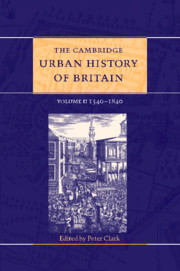Book contents
- Frontmatter
- 1 Introduction
- Part I Area surveys 1540–1840
- Part II Urban themes and types 1540–1700
- Part III Urban themes and types 1700–1840
- 14 Urban growth and economic change: from the late seventeenth century to 1841
- 15 Population and society 1700–1840
- 16 Politics and government 1700–1840
- 17 Culture and leisure 1700–1840
- 18 The transformation of urban space 1700–1840
- 19 London 1700–1840
- 20 Regional and county centres 1700–1840
- 21 Ports 1700–1840
- 22 Small towns 1700–1840
- 23 Health and leisure resorts 1700–1840
- 24 Industrialising towns 1700–1840
- 25 Conclusion
- Select Bibliography
- Index
- References
24 - Industrialising towns 1700–1840
from Part III - Urban themes and types 1700–1840
Published online by Cambridge University Press: 28 March 2008
- Frontmatter
- 1 Introduction
- Part I Area surveys 1540–1840
- Part II Urban themes and types 1540–1700
- Part III Urban themes and types 1700–1840
- 14 Urban growth and economic change: from the late seventeenth century to 1841
- 15 Population and society 1700–1840
- 16 Politics and government 1700–1840
- 17 Culture and leisure 1700–1840
- 18 The transformation of urban space 1700–1840
- 19 London 1700–1840
- 20 Regional and county centres 1700–1840
- 21 Ports 1700–1840
- 22 Small towns 1700–1840
- 23 Health and leisure resorts 1700–1840
- 24 Industrialising towns 1700–1840
- 25 Conclusion
- Select Bibliography
- Index
- References
Summary
industrial towns in the early nineteenth century were seen as sources of social and economic problems. ‘Degeneracy’, wrote Richard Ayton in Swansea in 1813, ‘results from the increase of manufactories, and the consequent attraction of a larger population to one point’. The expansion of manufactures was perceived during the debate on the ‘Condition of England’ question in the early 1840s to be responsible for many social ills, some of which were urban. The town of the mid-nineteenth century has come to be represented by a series of pessimistic images, like the view of the cotton mills alongside the Rochdale Canal at Ancoats, Manchester, published by George Pyne in 1829, and by several much-quoted descriptions: Engels and de Tocqueville on Little Ireland in Manchester, or Reach on the east end of Leeds. Peter Gaskell summarised a popular perception when he observed that ‘the universal application of steam-power … separates families; and … lessens the demand for human strength, reducing man to a mere watcher or feeder of his mighty assistant’.
Contemporaries were nevertheless aware that the development of manufactures was not synonymous with urban growth, that the factory system needed to be understood in rural as well as in urban contexts, at Egerton and Styal as well as in Manchester and Leeds. None of the industries which most conspicuously expanded in the century before 1840 – coal mining, textiles, the mining and processing of non-ferrous metals, ironmaking, hardware, glassmaking, ceramics – was essentially urban. Towns were significant in these industries, but they encompassed much activity outside urban limits.
- Type
- Chapter
- Information
- The Cambridge Urban History of Britain , pp. 805 - 830Publisher: Cambridge University PressPrint publication year: 2000
References
- 7
- Cited by

